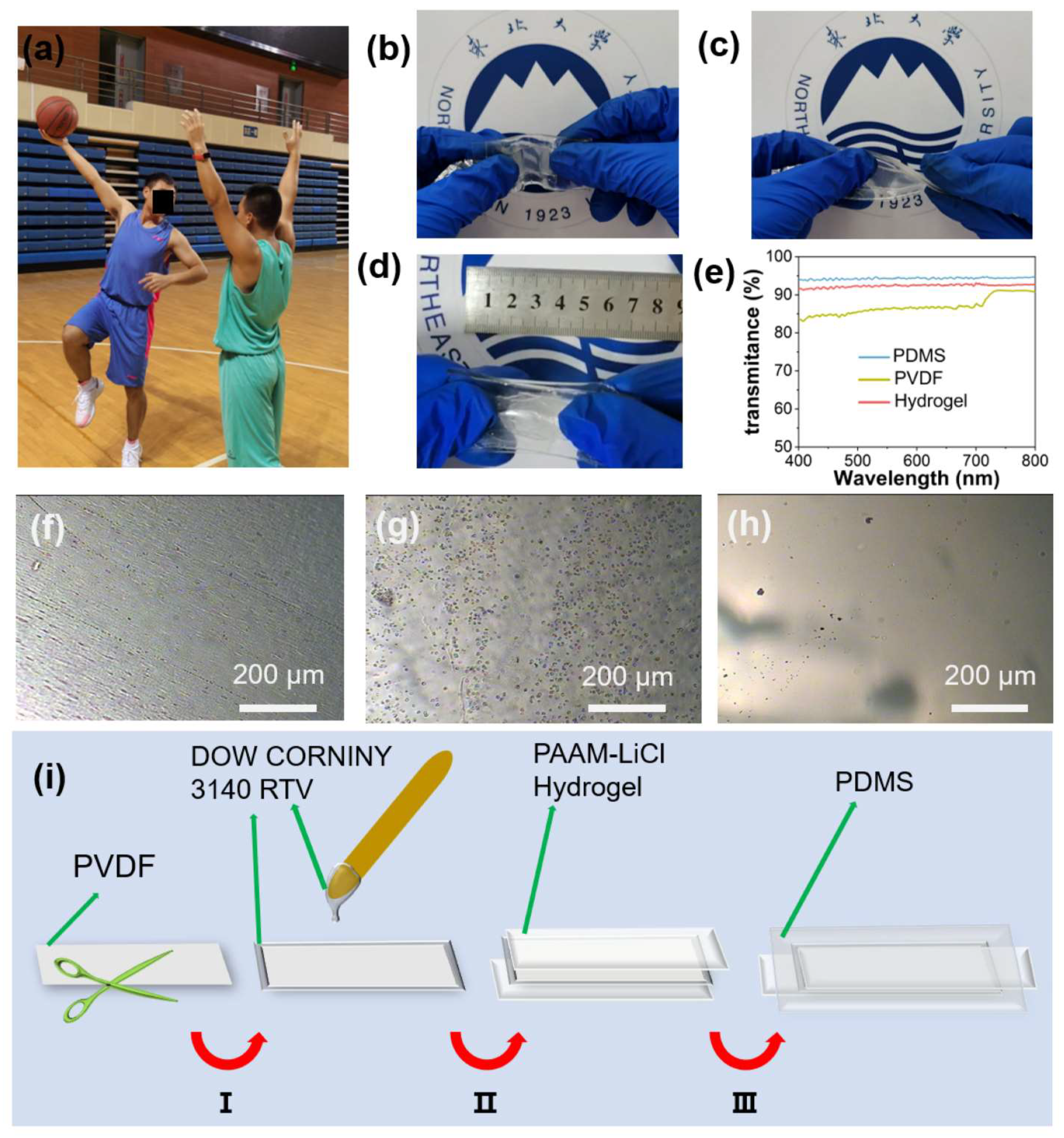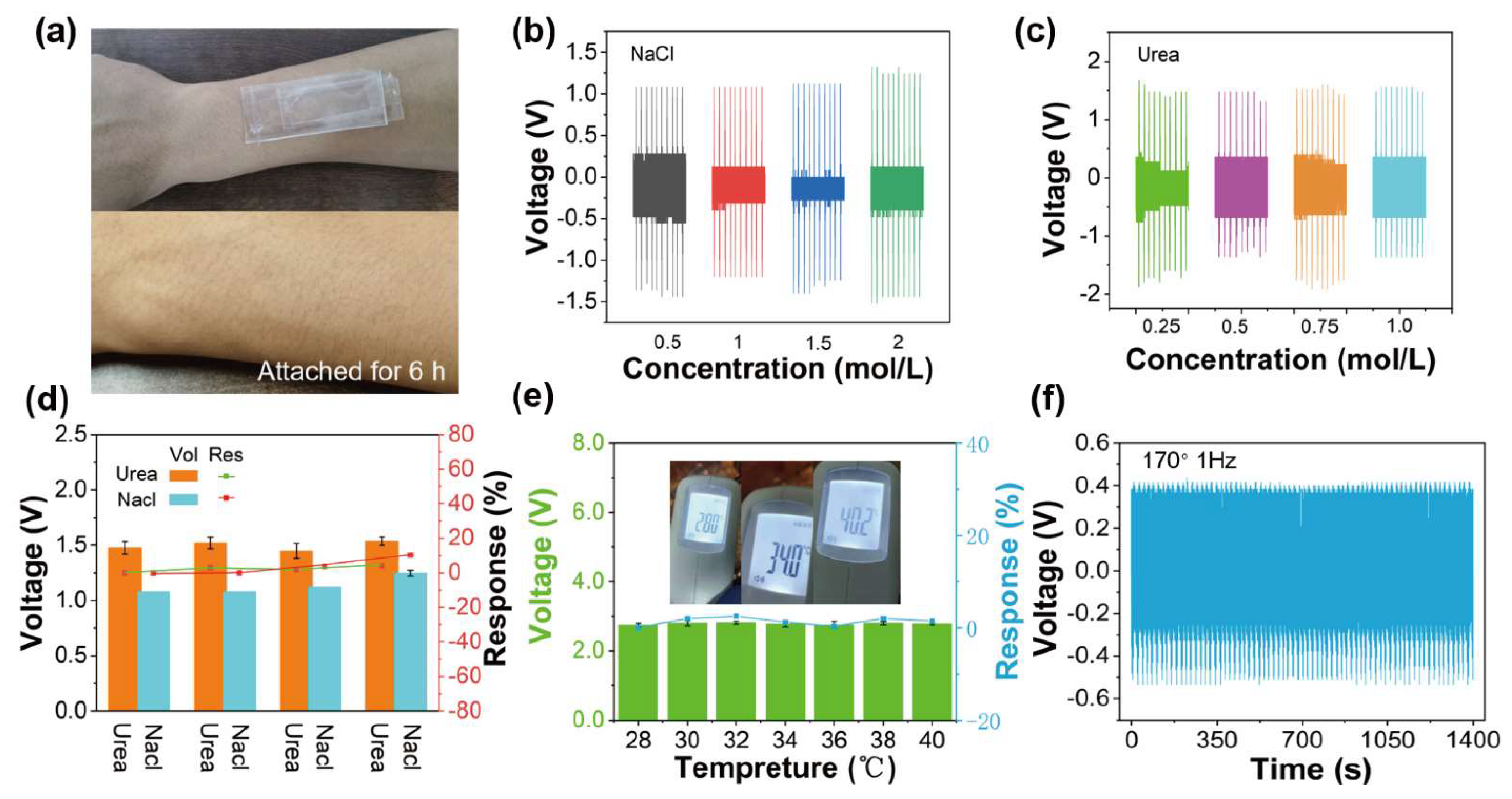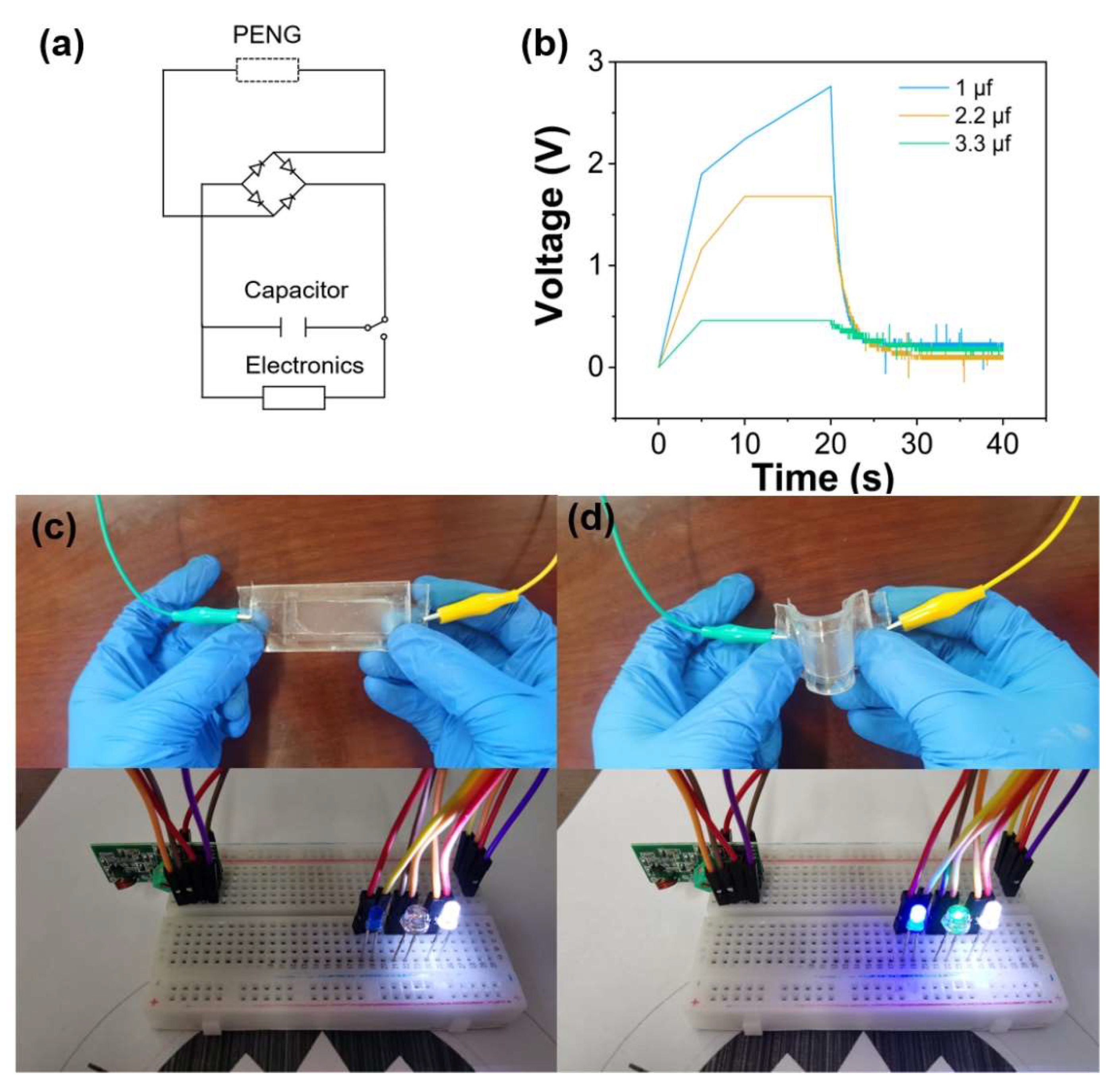A Flexible and Stretchable Self-Powered Nanogenerator in Basketball Passing Technology Monitoring
Abstract
:1. Introduction
2. Experimental Section
2.1. Materials
2.2. Manufacture of Piezoelectric Nanogenerator
2.3. Characterization and Measurement
3. Results
4. Discussion
5. Conclusions
Supplementary Materials
Author Contributions
Funding
Informed Consent Statement
Data Availability Statement
Acknowledgments
Conflicts of Interest
References
- Tian, X.; Lee, P.M.; Tan, Y.J.; Wu, T.L.; Yao, H.C.; Zhang, M.Y.; Li, Z.P.; Ng, K.A.; Tee, B.C.; Ho, J.S. Wireless body sensor networks based on metamaterial textiles. Nat. Electron. 2019, 2, 243–251. [Google Scholar] [CrossRef]
- Kim, H.; Kim, Y.S.; Mahmood, M.; Kwon, S.; Zavanelli, N.; Kim, H.S.; Rim, Y.S.; Epps, F.; Yeo, W.H. Fully Integrated, Stretchable, Wireless Skin-Conformal Bioelectronics for Continuous Stress Monitoring in Daily Life. Adv. Sci. 2020, 7, 2000810. [Google Scholar] [CrossRef] [PubMed]
- He, T.Y.; Wang, H.; Wang, J.H.; Tian, X.; Wen, F.; Shi, Q.F.; Ho, J.S.; Lee, C.K. Self-Sustainable Wearable Textile Nano-Energy Nano-System (NENS) for Next-Generation Healthcare Applications. Adv. Sci. 2019, 6, 1901437. [Google Scholar] [CrossRef] [PubMed] [Green Version]
- Wei, J.J.; Wang, Z.Y.; Xing, X.P. A Wireless High-Sensitivity Fetal Heart Sound Monitoring System. Sensors 2021, 21, 193. [Google Scholar] [CrossRef] [PubMed]
- Tang, Z.; Lin, S.Q.; Wang, Z.L. Quantifying Contact-Electrification Induced Charge Transfer on a Liquid Droplet after Contacting with a Liquid or Solid. Adv. Mater. 2021, 2102886. [Google Scholar] [CrossRef] [PubMed]
- Zhang, J.; Lin, S.; Zheng, M.; Wang, Z.L. Triboelectric Nanogenerator as a Probe for Measuring the Charge Transfer between Liquid and Solid Surfaces. ACS Nano 2021, 15, 14830–14837. [Google Scholar] [CrossRef] [PubMed]
- Xia, P.C.; Luo, J.J.; Wang, M.M. Adaptive compliant controller for space robot stabilization in postcapture phase. Proc. Inst. Mech. Eng. Part G J. Aerosp. Eng. 2021, 235, 937–948. [Google Scholar] [CrossRef]
- Ning, C.; Dong, K.; Gao, W.C.; Sheng, F.F.; Cheng, R.W.; Jiang, Y.; Yi, J.; Ye, C.Y.; Peng, X.; Wang, Z.L. Dual-mode thermal-regulating and self-powered pressure sensing hybrid smart fibers. Chem. Eng. J. 2021, 420, 129650. [Google Scholar] [CrossRef]
- Luo, J.J.; Gao, W.C.; Wang, Z.L. The Triboelectric Nanogenerator as an Innovative Technology toward Intelligent Sports. Adv. Mater. 2021, 33, 2004178. [Google Scholar] [CrossRef] [PubMed]
- Camomilla, V.; Bergamini, E.; Fantozzi, S.; Vannozzi, G. Trends Supporting the In-Field Use of Wearable Inertial Sensors for Sport Performance Evaluation: A Systematic Review. Sensors 2018, 18, 873. [Google Scholar] [CrossRef] [PubMed] [Green Version]
- Mendes, J.J.A.; Vieira, M.E.M.; Pires, M.B.; Stevan, S.L. Sensor Fusion and Smart Sensor in Sports and Biomedical Applications. Sensors 2016, 16, 1569. [Google Scholar] [CrossRef]
- Kos, A.; Umek, A. Smart sport equipment: SmartSki prototype for biofeedback applications in skiing. Pers. Ubiquit. Comput. 2018, 22, 535–544. [Google Scholar] [CrossRef]
- Li, R.T.; Kling, S.R.; Salata, M.J.; Cupp, S.A.; Sheehan, J.; Voos, J.E. Wearable Performance Devices in Sports Medicine. Sports Health 2016, 8, 74–78. [Google Scholar] [CrossRef] [PubMed] [Green Version]
- Luo, J.J.; Wang, Z.M.; Xu, L.; Wang, A.C.; Han, K.; Jiang, T.; Lai, Q.S.; Bai, Y.; Tang, W.; Fan, F.R.; et al. Flexible and durable wood-based triboelectric nanogenerators for self-powered sensing in athletic big data analytics. Nat. Commun. 2019, 10, 5147. [Google Scholar] [CrossRef] [Green Version]
- Mao, Y.P.; Zhu, Y.S.; Zhao, T.M.; Jia, C.J.; Bian, M.Y.; Li, X.X.; Liu, Y.G.; Liu, B.D. A Portable and Flexible Self-Powered Multifunctional Sensor for Real-Time Monitoring in Swimming. Biosensors 2021, 11, 147. [Google Scholar] [CrossRef]
- Zhao, C.L.; Jia, C.J.; Zhu, Y.S.; Zhao, T.M. An Effective Self-Powered Piezoelectric Sensor for Monitoring Basketball Skills. Sensors 2021, 21, 5144. [Google Scholar] [CrossRef]
- Mao, Y.P.; Zhu, Y.S.; Zhao, T.M.; Jia, C.J.; Wang, X.; Wang, Q. Portable Mobile Gait Monitor System Based on Triboelectric Nanogenerator for Monitoring Gait and Powering Electronics. Energies 2021, 14, 4996. [Google Scholar] [CrossRef]
- Mao, Y.; Zhang, W.; Wang, Y.; Guan, R.; Liu, B.; Wang, X.; Sun, Z.; Xing, L.; Chen, S.; Xue, X. Self-Powered Wearable Athletics Monitoring Nanodevice Based on ZnO Nanowire Piezoelectric-Biosensing Unit Arrays. Sci. Adv. Mater. 2019, 11, 351–359. [Google Scholar] [CrossRef]
- Mao, Y.P.; Shen, M.L.; Liu, B.; Xing, L.L.; Chen, S.; Xue, X.Y. Self-Powered Piezoelectric-Biosensing Textiles for the Physiological Monitoring and Time-Motion Analysis of Individual Sports. Sensors 2019, 19, 3310. [Google Scholar] [CrossRef] [Green Version]
- Mao, Y.P.; Zhu, Y.S.; Jia, C.J.; Zhao, T.M.; Zhu, J.B. A Self-Powered Flexible Biosensor for Human Exercise Intensity Monitoring. J. Nanoelectron. Optoelectron. 2021, 16, 699–706. [Google Scholar] [CrossRef]
- Xu, S.X.; Song, J. Study on the High-level Basketball Team Competence and Winning Methods. In Proceedings of the 2012 Third International Conference on Education and Sports Education (ESE 2012), Vol III 3rd International Conference on Education and Sports Education (ESE 2012), Macau, China, 1–2 April 2012; Singapore Management & Sports Science INST PTE Ltd.: Singapore, 2012. [Google Scholar]
- Zhou, X.J.; Gao, Z.; Zhang, Q.L. Analysis Approach of Winning Factors in Competitive Basketball. In Proceedings of the 2008 IEEE International Symposium on Knowledge Acquisition and Modeling Workshop Proceedings, Vols 1 and 2, International Symposium on Knowledge Acquisition and Modeling, Wuhan, China, 21–22 December 2008; IEEE: New York, NY, USA, 2008. [Google Scholar]
- Papadimitriou, K.; Taxildaris, K.; Derri, V.; Mantis, K. Profile of different level basketball centers. J. Hum. Mov. Stud. 1999, 37, 87–105. [Google Scholar]
- Sindik, J.; Nazor, D. Differences in Conative Characteristics and Perceived Group Cohesion of the Basketball Players Playing in Different Positions in the Team. Coll. Antropol. 2011, 35, 895–904. [Google Scholar] [PubMed]
- Sekulic, D.; Pehar, M.; Krolo, A.; Spasic, M.; Uljevic, O.; Calleja-Gonzalez, J.; Sattler, T. Evaluation of Basketball-Specific Agility: Applicability of Preplanned and Nonplanned Agility Performances for Differentiating Playing Positions and Playing Levels. J. Strength Cond. Res. 2017, 31, 2278–2288. [Google Scholar] [CrossRef]
- Stewart, J.C.; Yeh, S.C.; Jung, Y.B.; Yoon, H.J.; Whitford, M.; Chen, S.Y.; Li, L.; McLaughlin, M.; Rizzo, A.; Winstein, C.J. Intervention to enhance skilled arm and hand movements after stroke: A feasibility study using a new virtual reality system. J. Neuroeng. Rehabil. 2007, 4, 21. [Google Scholar] [CrossRef] [PubMed] [Green Version]
- Struzik, A.; Pietraszewski, B.; Zawadzki, J. Biomechanical Analysis of the Jump Shot in Basketball. J. Hum. Kinet. 2014, 42, 73–79. [Google Scholar] [CrossRef] [PubMed] [Green Version]
- Sosa, C.; Lorenzo, A.; Trapero, J.; Ribas, C.; Alonso, E.; Jimenez, S.L. Specific Absolute Velocity Thresholds during Male Basketball Games Using Local Positional System; Differences between Age Categories. Appl. Sci. 2021, 11, 4390. [Google Scholar] [CrossRef]
- Malone, L.A.; Gervais, P.L.; Steadward, R.D. Shooting mechanics related to player classification and free throw success in wheelchair basketball. J. Rehabil. Res. Dev. 2002, 39, 701–709. [Google Scholar] [PubMed]
- de Oliveira, G.C.M.; Carvalho, J.H.D.; Brazaca, L.C.; Vieira, N.C.S.; Janegitz, B.C. Flexible platinum electrodes as electrochemical sensor and immunosensor for Parkinson’s disease biomarkers. Biosensors 2020, 152, 112016. [Google Scholar] [CrossRef]
- Li, Y.T.; Miao, X.H.; Niu, L.; Jiang, G.M.; Ma, P.B. Human Motion Recognition of Knitted Flexible Sensor in Walking Cycle. Sensors 2020, 20, 35. [Google Scholar] [CrossRef] [Green Version]
- Jiang, X.N.; Kim, K.; Zhang, S.J.; Johnson, J.; Salazar, G. High-Temperature Piezoelectric Sensing. Sensors 2014, 14, 144–169. [Google Scholar] [CrossRef] [Green Version]
- Wooten, J.M.; Bevly, D.M.; Hung, J.Y. Piezoelectric Polymer-Based Collision Detection Sensor for Robotic Applications. Electronics 2015, 4, 204–220. [Google Scholar] [CrossRef] [Green Version]
- Del-Rio-Ruiz, R.; Echevarria, J.J.; Eguiluz, X.; Lopez-Garde, J.M.; Legarda, J. Experimental Frequency Tuning Methodology of a Cantilever Piezoelectric Harvester Validated in a Multimodal Transportation. Electronics 2020, 9, 79. [Google Scholar] [CrossRef] [Green Version]
- Jeong, S.Y.; Cho, J.Y.; Hong, S.D.; Hwang, W.; Jabbar, H.; Ahn, J.H.; Jhun, J.P.; Sung, T.H. Self-Powered Operational Amplifying System with a Bipolar Voltage Generator Using a Piezoelectric Energy Harvester. Electronics 2020, 9, 41. [Google Scholar] [CrossRef] [Green Version]
- Wang, D.W.; Fan, Z.M.; Rao, G.H.; Wang, G.; Liu, Y.; Yuan, C.L.; Ma, T.; Li, D.J.; Tan, X.L.; Lu, Z.L.; et al. Ultrahigh piezoelectricity in lead-free piezoceramics by synergistic design. Nano Energy 2020, 76, 104944. [Google Scholar] [CrossRef]
- He, Y.X.; Yang, Q.; Luo, M.D.; Liu, R.Y. Effect of the physical parameters of longitudinally polarized PZT tubes on PZT sensors. J. Phys. D Appl. Phys. 2020, 53, 275501. [Google Scholar] [CrossRef]
- Li, F.; Cabral, M.J.; Xu, B.; Cheng, Z.X.; Dickey, E.C.; LeBeau, J.M.; Wang, J.L.; Luo, J.; Taylor, S.; Hackenberger, W.; et al. Giant piezoelectricity of Sm-doped Pb(Mg1/3Nb2/3)O-3-PbTiO3 single crystals. Science 2019, 364, 264–268. [Google Scholar] [CrossRef]
- Qiu, C.R.; Wang, B.; Zhang, N.; Zhang, S.J.; Liu, J.F.; Walker, D.; Wang, Y.; Tian, H.; Shrout, T.R.; Xu, Z.; et al. Transparent ferroelectric crystals with ultrahigh piezoelectricity. Nature 2020, 577, 350–354. [Google Scholar] [CrossRef]
- Park, K.I.; Jeong, C.K.; Ryu, J.; Hwang, G.T.; Lee, K.J. Flexible and Large-Area Nanocomposite Generators Based on Lead Zirconate Titanate Particles and Carbon Nanotubes. Adv. Energy Mater. 2013, 3, 1539–1544. [Google Scholar] [CrossRef]
- Sato, K.; Kang, W.H.; Saga, K.; Sato, K.T. Biology of sweat glands and its disorders. I. Normal sweat gland function. J. Am. Acad. Dermatol. 1989, 20, 713–726. [Google Scholar] [CrossRef]
- Raiszadeh, M.M.; Ross, M.M.; Russo, P.S.; Schaepper, M.A.; Zhou, W.D.; Deng, J.H.; Ng, D.; Dickson, A.; Dickson, C.; Strom, M.; et al. Proteomic Analysis of Eccrine Sweat: Implications for the Discovery of Schizophrenia Biomarker Proteins. J. Proteome Res. 2012, 11, 2127–2139. [Google Scholar] [CrossRef] [Green Version]
- Manjakkal, L.; Pullanchiyodan, A.; Yogeswaran, N.; Hosseini, E.S.; Dahiya, R. A Wearable Supercapacitor Based on Conductive PEDOT:PSS-Coated Cloth and a Sweat Electrolyte. Adv. Mater. 2020, 32, 1907254. [Google Scholar] [CrossRef] [PubMed]
- Wang, J.Y.; Liu, W.H.; Moffit, J. Skills and Offensive Tactics Used in Pick-up Basketball Games. Percept. Motor Skill 2009, 109, 473–477. [Google Scholar] [CrossRef] [PubMed]






Publisher’s Note: MDPI stays neutral with regard to jurisdictional claims in published maps and institutional affiliations. |
© 2021 by the authors. Licensee MDPI, Basel, Switzerland. This article is an open access article distributed under the terms and conditions of the Creative Commons Attribution (CC BY) license (https://creativecommons.org/licenses/by/4.0/).
Share and Cite
Jia, C.; Zhu, Y.; Sun, F.; Zhao, T.; Xing, R.; Mao, Y.; Zhao, C. A Flexible and Stretchable Self-Powered Nanogenerator in Basketball Passing Technology Monitoring. Electronics 2021, 10, 2584. https://doi.org/10.3390/electronics10212584
Jia C, Zhu Y, Sun F, Zhao T, Xing R, Mao Y, Zhao C. A Flexible and Stretchable Self-Powered Nanogenerator in Basketball Passing Technology Monitoring. Electronics. 2021; 10(21):2584. https://doi.org/10.3390/electronics10212584
Chicago/Turabian StyleJia, Changjun, Yongsheng Zhu, Fengxin Sun, Tianming Zhao, Rongda Xing, Yupeng Mao, and Chongle Zhao. 2021. "A Flexible and Stretchable Self-Powered Nanogenerator in Basketball Passing Technology Monitoring" Electronics 10, no. 21: 2584. https://doi.org/10.3390/electronics10212584
APA StyleJia, C., Zhu, Y., Sun, F., Zhao, T., Xing, R., Mao, Y., & Zhao, C. (2021). A Flexible and Stretchable Self-Powered Nanogenerator in Basketball Passing Technology Monitoring. Electronics, 10(21), 2584. https://doi.org/10.3390/electronics10212584








